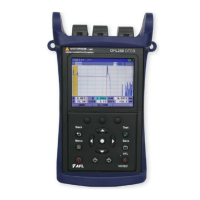10
Parameter Description
Range The Range parameter determines the distance range of the full (unzoomed)
trace. It also determines Resolution - the distance between data points in the
trace: the longer the range, the wider the data point spacing. We recommend
selecting the shortest distance range that is longer than the fiber under test. For
example, to test a fiber that is 1.5 km long, select the 2.5 km range.
Available Range values:
Range Resolution (set by OFL250)
< 4 km (13123 ft) 0.25 m (0.82 ft)
8 - 16 km (26246 ft) 0.5 m (1.64 ft)
16 - 32 km (52493 ft) 1 m (3.28 ft)
32 km (104986 ft) range/ 1600 m (range/ 5249 ft)
Filter The Filter should be turned ON to test very long fibers. Turn the filter ON if you
are using a pulse width of 1 us or greater. Turning the Filter ON makes a choppy
or noisy trace smoother.
Pulse The OFL250 can operate using different pulse widths. Short pulse widths
provide the shortest event and attenuation dead zones. Long pulse widths
provide the range needed to test long fibers.
Available Pulse values: 10, 30, 100, 300 ns, 1, 3, 10 ms.
Averaging The Averaging parameter determines the duration of a timed test and the
number of trace averages performed. The longer the test the smoother the trace.
Available Averaging values: 5, 10, 30, 60, 90, 180 sec.
OTDR Test Settings
Understanding OTDR Test Parameters
Full Auto Mode Settings
Use Left/Right arrow
key to select the desired
single wavelength or dual
wavelengths.
These parameters are set
by OFL250 OTDR.
In the Full Auto test mode, you may select the desired test wavelengths while the Range, Filter,
Pulse, and Averaging parameters are set by the OFL250.
1. From the displayed Full Auto submenu, use keys to highlight Wavelength.
2. Use keys to select a single wavelength or dual wavelength.

